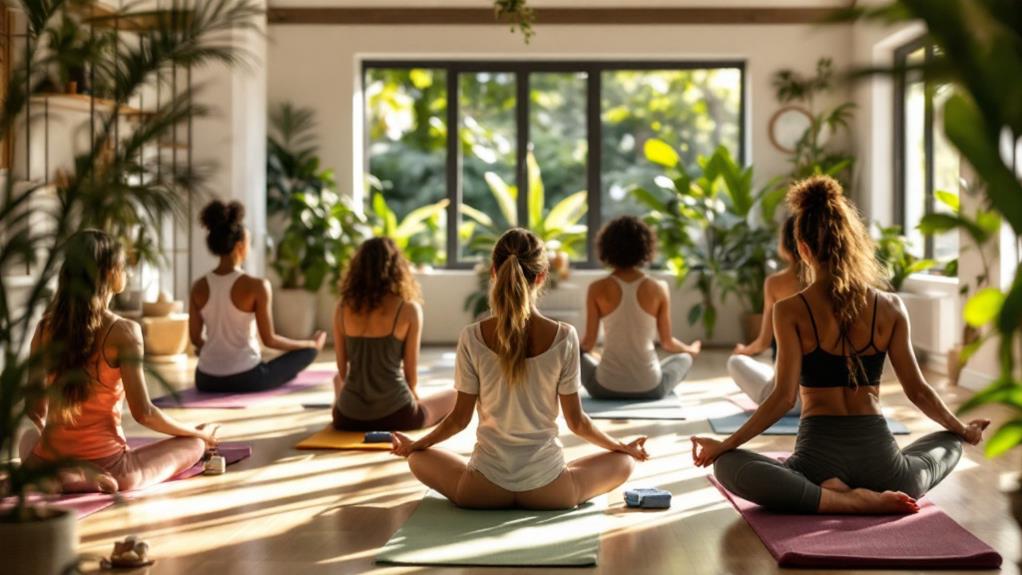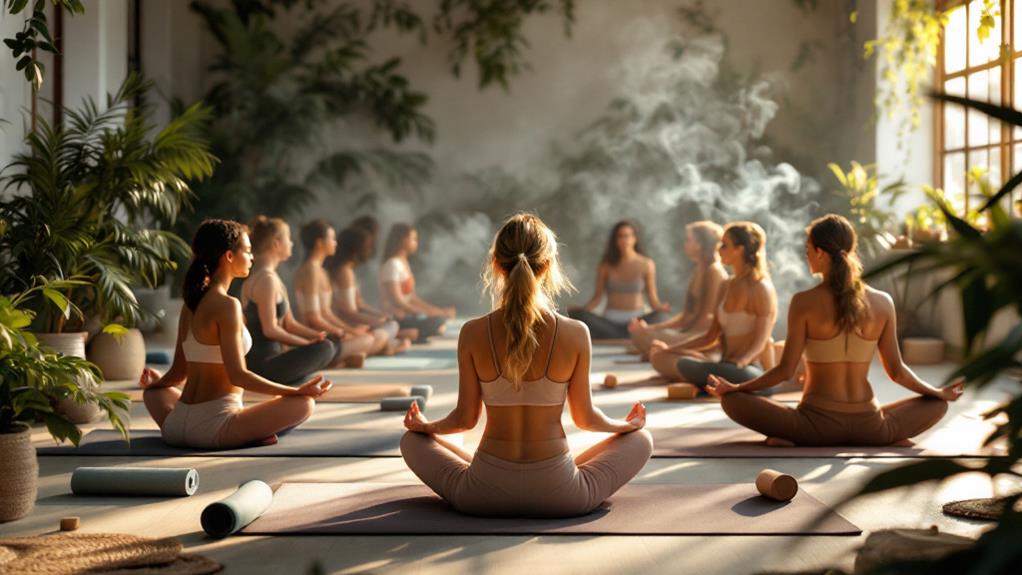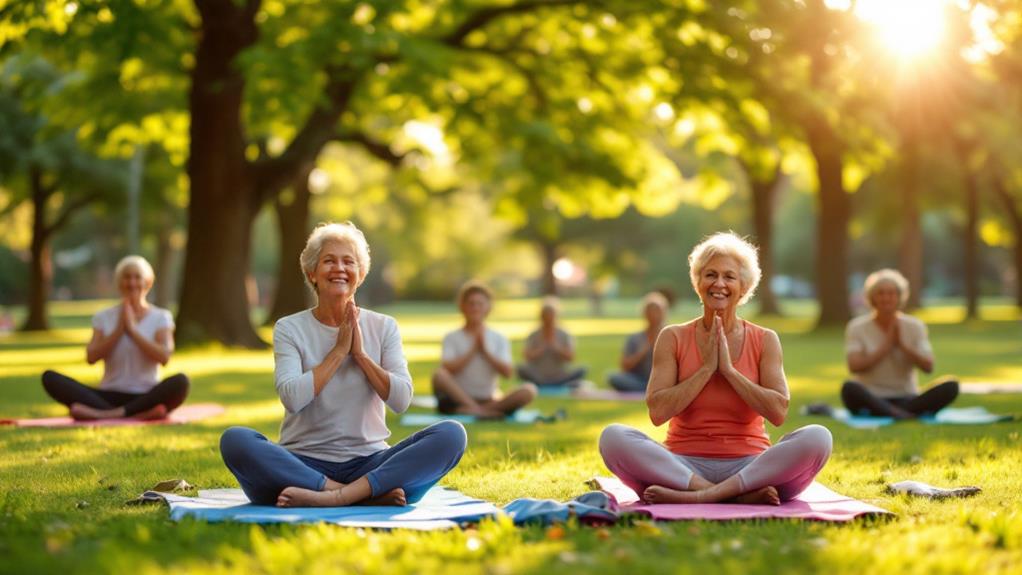The Yogi’s Playlist: The Best Music for Yoga and Total Empowerment
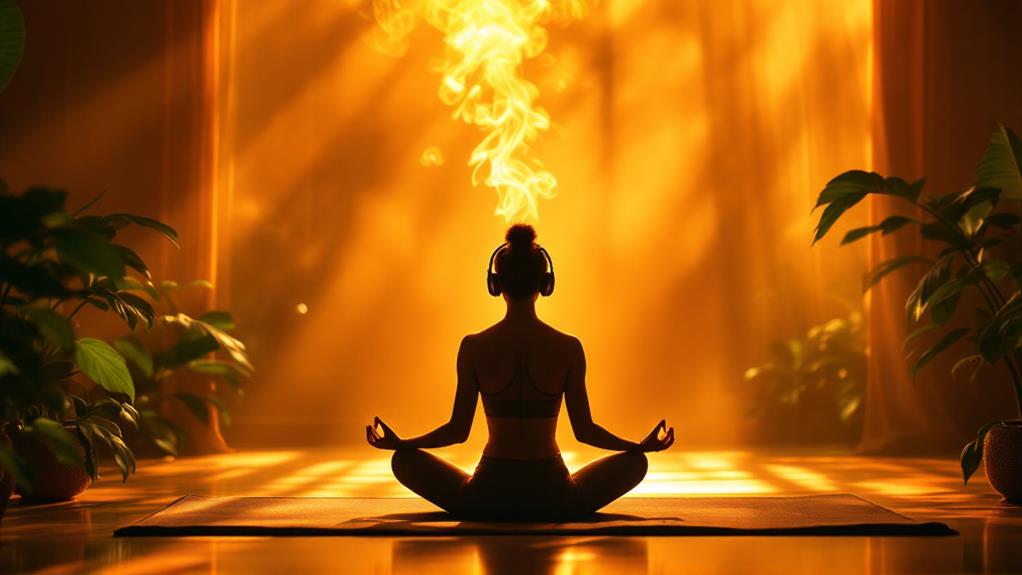
Choosing the right music can greatly improve your yoga practice, turning it into a more empowering and seamless experience. Upbeat tracks provide energy for your sequences, while mellow tunes offer peace during restorative poses. Instrumental music helps you focus on breath and mindfulness, and engaging lyrics can deepen introspective moments. Mixing diverse genres enriches the emotional depth of your practice, and sharing musical preferences with fellow yogis builds community and connection. Don't overlook legal considerations, like royalty payments, when creating your playlist. There's much more to investigate about crafting the ideal yoga soundtrack.
Understanding Music's Role in Yoga
How does music transform a yoga session from routine to extraordinary? When you incorporate music into your yoga practice, it can markedly improve your experience by setting the rhythm and flow of your movements. Imagine how upbeat tracks can energize your sequences, helping you stay in sync with your breath and body. These lively tunes can inject energy into your practice, making every pose feel dynamic and alive.
On the other hand, when you switch to mellow tunes, especially during restorative poses like savasana, you create a serene, balanced atmosphere. This gentle backdrop encourages relaxation and invites deeper focus, making it easier to connect with your breath and movements without the distraction of verbal cues. Instrumental music often works best here, as it allows you to plunge deeper into mindfulness and self-discovery.
Furthermore, engaging with others about their musical preferences can foster a sense of community and boost your complete yoga experience. When you feel connected through shared musical tastes, it's easier to envelop yourself fully in the practice. Music doesn't just serve as a backdrop; it amplifies your emotional connection, encouraging a more mindful experience on the mat.
Curating Your Yoga Playlist
In relation to curating your yoga playlist, it's essential to choose tracks that enhance the emotional connection and rhythm of your practice. You want music that aligns with your movements, helping you maintain a steady breath. Think about the tempo and length of each track. They should seamlessly match the flow of your yoga sequence, ensuring a smooth shift between poses. Diverse musical styles, like ambient instrumentals or soft reggae, can set different moods, enhancing your practice's emotional depth.
Consider tracks that offer verbal cues, such as those from MC Yogi's "Pilgrimage" album. These can guide your breath control and keep you focused. When you hear a gentle reminder to breathe deeply, it reinforces your connection to the practice. Engaging with your students or fellow yogis can be crucial. Gathering feedback helps you tailor the playlist to preferences, fostering a sense of community and shared enjoyment.
Exploring Diverse Musical Genres

When exploring diverse musical genres for your yoga playlist, you'll uncover how different styles can improve your practice. By integrating a variety of sounds, you can create a dynamic and enriching environment for yoga classes. MC Yogi's album "Pilgrimage" offers a perfect example, blending hip-hop, reggae, tribal-dance, and dub. This fusion not only provides a unique auditory experience but also strengthens your ability to connect with the rhythm and flow of each session.
Tracks like "Breath Control" and "Born to Fly" showcase this blend beautifully, using rap and reggae to craft soundscapes that boost your yoga flow and emotional experience. The inclusion of Indian sounds, recorded in India, further deepens the cultural connection to yoga's origins, offering a richer experience.
The presence of a prominent horn section throughout the album adds uplifting energy, appealing to a broad audience and improving both your practice and sense of empowerment. By curating playlists that include a range of genres, you guarantee that both mellow and energetic tracks are available. This variety caters to different yoga styles and participant preferences, making your sessions more engaging and profound.
Empowering Tracks for Practice
Empowerment pulses through your yoga practice with the right tracks. Imagine starting your session with "Sun Light" by MC Yogi. Its triumphant horn riffs energize your movements, transforming each pose into a celebration of strength and vigor. This anthem becomes your rhythmic guide, enhancing the energy and vibrancy of your yoga flow.
Switch to "Born to Fly" to infuse your practice with reggae vibes. This track delivers a message of freedom, liberating your spirit as you shift from one pose to another. Feel the sense of release and expansion, allowing your body to move with a newfound sense of ease and joy.
For those moments when you want to shake things up, "Gimme What I Want" by Miley Cyrus turns your yoga session into an upbeat dance party. The pulsating rhythm encourages self-expression, infusing your practice with a playful, energetic twist. As you sway and move, you connect deeply with your inner power.
On the other hand, "While We're Young" by Jhené Aiko offers a soothing backdrop for relaxation. This track creates an atmosphere that invites spontaneity and calm, perfectly complementing the diverse emotions you investigate during your practice.
Balancing Energy and Calm
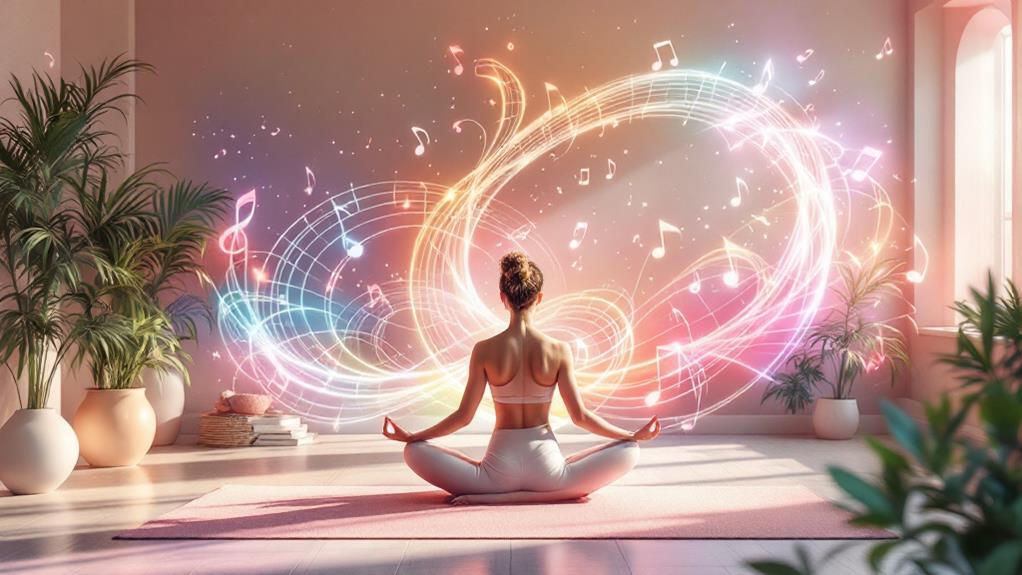
Balancing energy and calm in your yoga practice is an art that a well-curated playlist can masterfully achieve. Imagine starting your yoga class with energetic tracks like "Gimme What I Want" by Miley Cyrus, which invigorate your movements and add a lively pulse to your practice. These tracks get your heart pumping and enhance your focus, making dynamic flows feel empowering and alive. As you shift into more restorative poses, the playlist can seamlessly guide you into a state of total relaxation.
Incorporating diverse musical styles like reggae and hip-hop from MC Yogi's "Pilgrimage" can boost your energy during active sequences. These upbeat genres create a rhythmic cadence that keeps you engaged and motivated. However, as you wind down towards savasana, soothing instrumentals gently bring your mind to a serene space, enhancing mindfulness and deep relaxation.
Feedback from students often highlights the importance of this strategic balance. They appreciate how a thoughtful mix of upbeat and mellow tunes supports a harmonious environment, effortlessly guiding them through different energies and intensities. By carefully selecting your playlist, you maintain rhythm and flow, ensuring every shift resonates with balance and tranquility.
Integrating Instrumental Music
Integrating instrumental music into your yoga practice can profoundly improve your experience, allowing for a deeper connection to your breath and movements. Without lyrics diverting your attention, instrumental music like José González's simple melodies can help you stay engaged in the present moment. The steady guitar strumming provides a rhythmic anchor, enhancing your focus on breath and internal sensations. This makes it ideal for grounding and centering before you shift into movement.
During your practice, instrumental tracks promote a steady breath, allowing you to explore deeper into your poses and maintain a profound connection to the present moment. Music selections like "River" by Leon Bridges can evoke strong emotional responses while maintaining a calming musical backdrop. This combination not only facilitates emotional release but also fosters relaxation and mindfulness.
Lyrics and Introspection
While instrumental music provides a serene backdrop for yoga, incorporating lyrical content can add a new layer of introspection to your practice. Songs with lyrics like "Sort of Revolution" by Fink encourage a meditative rhythm, supporting your initial movements and inviting deeper self-reflection. As you flow through your practice, these songs can guide you into a state of mindfulness, allowing you to investigate your inner landscape with each pose.
Emotionally charged lyrics, such as those in "River" by Leon Bridges, improve your yoga experience by encouraging you to surrender to your feelings. This emotional release can be both cathartic and empowering, promoting a sense of vulnerability that enriches your practice. Songs with themes of presence and gratitude, like "These Days are Numbered" by The Head and the Heart, remind you to cherish the present moment, deepening your connection to your breath and movement.
The balance of lyrical content and calming melodies in tracks like "Cherry Wine" by Hozier creates a grounding ambiance perfect for restorative sessions. By choosing songs with lyrics that evoke introspection, you cultivate a mindful and enriched yoga experience.
Emotional Connection Through Sound
Through the power of music, you can deepen your emotional connection during yoga sessions. Music evokes strong emotional responses, improving your practice by allowing emotional release and connecting you more profoundly to your body and breath. Yoga teachers often use songs like "River" by Leon Bridges to create an atmosphere conducive to vulnerability, encouraging you to surrender to your feelings. Here are some ways music fosters an emotional connection in yoga:
- Mindfulness: Songs with lyrical content, like "These Days Are Numbered" by The Head and the Heart, remind you to cherish the present moment, promoting mindfulness during your practice.
- Emotional Release: Certain songs evoke deep emotions, allowing you to release pent-up feelings and connect more deeply with yourself.
- Mood Improvement: Studies show that sound can positively influence your emotional well-being. Music with emotional resonance enhances your mood and reduces stress, making your yoga experience more fulfilling.
- Introspection: Integrating musical themes of gratitude and presence encourages introspection, improving the complete engaging experience in your practice.
Yoga teachers recognize how music's emotional resonance can transform your sessions, making them more meaningful and empowering.
Community and Shared Experiences
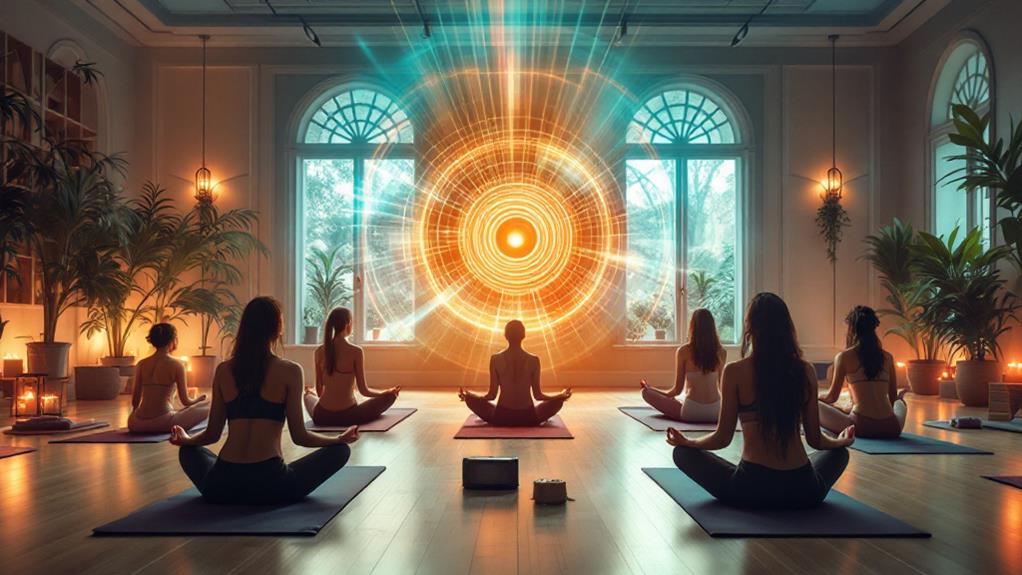
Amid the harmony of yoga and music, fostering community and shared experiences can improve your practice to new heights. When you engage with fellow yogis, the energy transforms, creating a supportive environment where everyone thrives. Tools like Survey Monkey can help instructors gauge your music preferences, ensuring the playlists resonate with everyone in the class and promote a collaborative atmosphere.
Sharing playlists within your yoga community strengthens the bonds between practitioners. You connect over shared musical experiences, deepening relationships and improving your practice. Live music sessions further enrich this connection, turning classes into lively, energetic gatherings that attract new participants and build a unified community through shared experiences.
Festivals like the Wanderlust Festival epitomize community connection by merging music, yoga, and partnership activities. They encourage you to engage in meaningful discussions and collaborations, fostering a sense of belonging. Partner work, such as acro yoga, also plays an essential role in cultivating trust and communication. These shared experiences are significant, offering mutual support and a deeper understanding of yoga.
Accessibility and Legal Considerations
Guiding the world of music in yoga classes involves understanding both accessibility and legal considerations. When you play music in your yoga studio, it's seen as a public performance, which means you might need to pay royalties depending on how many people attend. These royalties are vital because they support the legal rights of copyright holders. Ignoring them can lead to copyright claims from organizations like ASCAP.
To keep everything above board, here are some significant steps you should consider:
- License Acquisition: Obtain the necessary licenses to legally play music during your classes. This step helps you avoid any legal issues and guarantees compliance with copyright laws.
- Mindful Online Sharing: If you record and share your classes online, be aware that YouTube algorithms can monetize videos with copyrighted music, impacting your content's availability.
- Student Feedback: Listen to your students' growing desire for more music in classes. It's important to balance their needs while keeping copyright regulations in check.
- Explore Alternatives: Consider using royalty-free music or creating your playlists from music with open licenses to maintain accessibility without legal concerns.
Navigating these considerations can empower your classes with music while staying legally sound.

